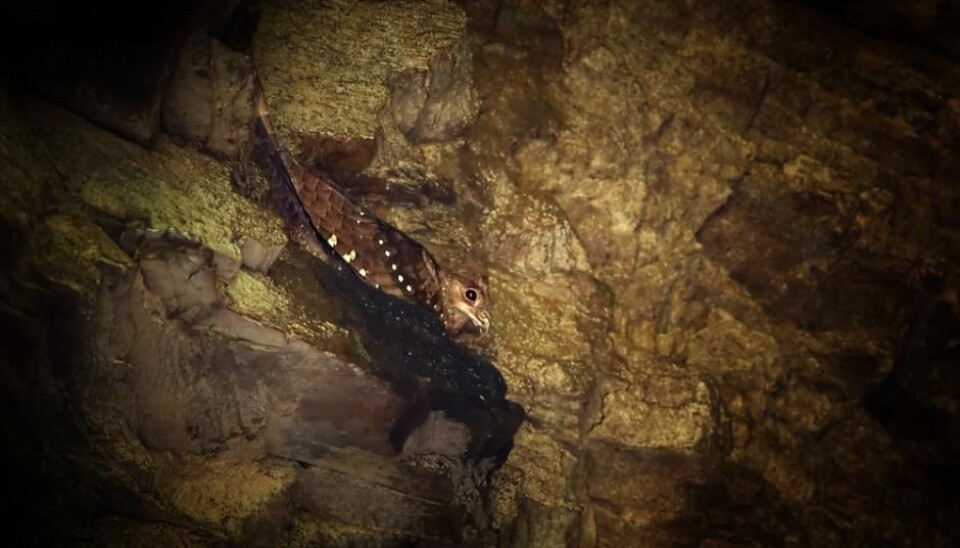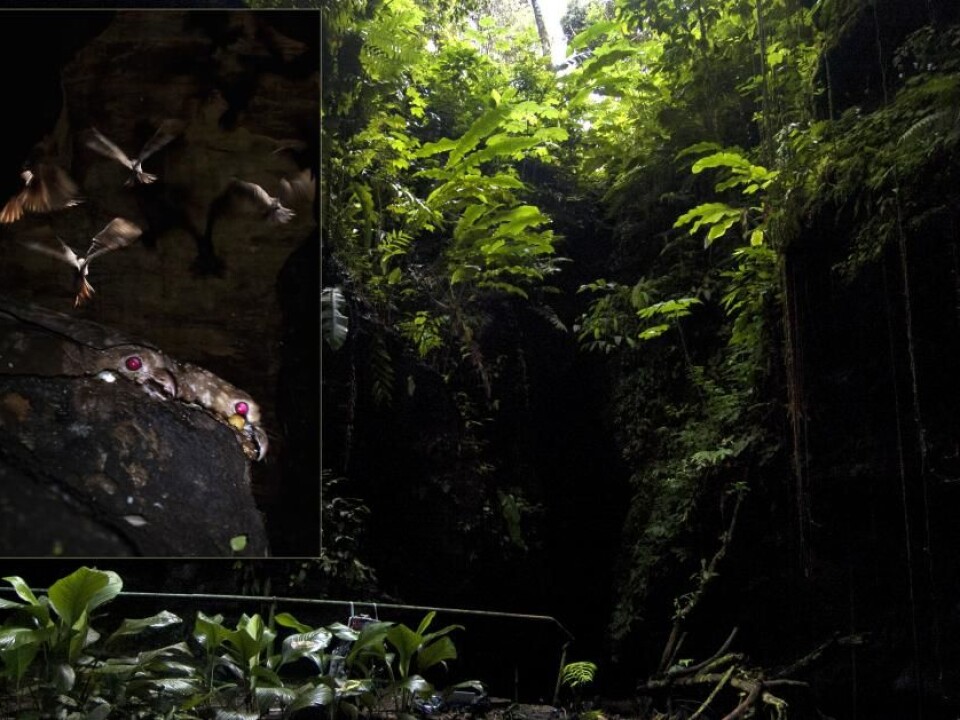
Bird senses can improve drone navigation
South American oilbirds combine echolocation and extremely sensitive vision to find their way through dark caves. Decoding how they do this could help develop autonomous drones.
The Danish Drone Strategy aims to put Denmark at the forefront of state-of-the-art drone technology. Both the number of commercial users and authorised drone operators are rising. But for security reasons, the law requires drones to operate within the drone pilot’s range of sight.
This limits the use of drones to good visibility conditions and limits their full potential. For example, routine monitoring tasks could be hindered by foggy or cloudy weather. And emergency situations, such as a forest fire or a burning building, could benefit from a drone controlled not by a pilot on the ground, but autonomously via automatic recognition of obstacles.
The question is, how can we further develop and optimise drone technology to avoid such concerns?
Oilbirds, form South America, also known as the guácharo, might hold the answer. But before we get to that, let’s consider some examples of how we imitate nature.
Active sensory perception and biomimetic inspiration

By mimicking the shape and function of nature, biologists and engineers have created so-called biomimetic robots that are experts in parkour, able to hear like a lizard, and smell like a sniffer dog.
Why can’t similar inspiration lead to improvements in drone navigation systems, for example, from animals, which have adapted to variable or low light conditions?
Most sensory systems are passive, relying on external signals to activate the nervous system. For example, light energy is required to activate our sense of sight, enabling us to see.
Echolocation is one of the few senses that doesn’t rely on external energy. Instead it is the animal itself that probes the surroundings by actively emitting signals that subsequently send sensory input back from the surroundings, which the brain then interprets.
Bats: The uncrowned kings of echolocation

Most people know that bats are experts in echolocation and navigating their way around the night sky, catching their prey by emitting sound and listening for the echoes reflected off their surroundings. This allows them to for example, differentiate between tasty snacks and obstacles.
The physical relationship between the size of an object and the frequencies contained in the echolocation signal determines how strong an echo the object returns. In general, the higher the signal frequency, the smaller the object that can be detected. As bats most often use ultrasound with frequencies above our hearing range, this allows them to detect objects of just a few millimetres size, such as insects.
Bats are the uncrowned kings of echolocation and their biosonar capabilities are well-studied, making them a seemingly perfect candidate from which to develop a biomimetic model for drone-sonar.
But since they are much smaller and more manoeuvrable in comparison to most drones available today, this makes them a difficult model to use. Moreover, their status as echolocation experts is the result of 65 million years of evolution.
They have large, often complex, outer ears to help to them determine the direction of sound and echoes, along with enlarged sections of the inner ear, and highly developed parts of the brain dedicated to handle the sound input.
Scientists have struggled to mimic these prerequisites in biomimetic robots.
The oilbird: grease wrapped in feathers
This is where oilbirds come into the picture. Oilbirds are a curious night-active and fruit-eating member of the Caprimulgiformes order of birds and live in caves in the rainforests of tropical South America.
Shortly before they leave the nest, young oilbirds plump up to greatly exceed the adult 400 g weight of their parents. Like many species of whale, the oilbirds were hunted by natives and early European settlers for their fat, which was used for lamps and cooking.
Despite their considerable weight, the broad wings and large wingspan of oilbirds – up to almost one metre – enable them to hover almost motionless in the sky, like a hummingbird.
Conversely, they cannot balance on one leg or perch on a vertical surface, a curious flaw for a bird that builds nests on small ledges in dark caves, where they hide away during the day.
Echolocation adapted to light conditions
Studies of the oilbird sensory system have revealed that they are much more than grease in feathers!
Like bats, they can also use echolocation to move around and do so as they fly to and from their nests within the dark caves where they roost during the day.
As far as we know, oilbirds do not use echolocation to hunt. Even though they are nocturnal, they navigate primarily by sight and may have the most sensitive sight of any vertebrate.
Their inability to balance on cliff ledges requires precision landing skills, especially in a pitch black cave, where hundreds of birds can be in flight at any one time and the noise levels can be immense. Echolocation helps the birds solve this challenge.
Oilbirds are difficult to study, because they are shy, do not live long in captivity, and inhabit inaccessible areas. So we still know relatively little about their echolocation system.
But what makes oilbirds interesting is that unlike bats, they are able to use echolocation without big external ears, ultrasound, or any known neurological hearing specialisations.
By studying the oilbirds’ echolocation behaviour in nature, my colleagues and I have recently discovered that they actively adapt the volume of their sound signals according to the light levels of their surroundings.
We recorded the birds using multiple microphones while they flew in and out of the cave entrance. You can listen to their echolocation signals below.
In this way we were able to use the delay between the sound signals recorded by the microphones to determine the bird’s position in the air and for the first time, calculate the intensity of their sonar signals.
Sound loses energy as it travels away from its source, in this case from the oilbird to microphone. But this loss is predictable and we can compensate for it if we know the distance between sender and reciever.
Easier to mimic oilbirds than bats
Our recordings showed that the oilbirds emit lower intensity sonar signals under good light conditions near the full moon, while they generally increase the volume on moonless nights when the surrounding light level decreases.
This tells us that they increase the range of their echolocation as they find it more difficult to see.
The interplay between these two sensory systems guides their behaviour and optimises their performance, so they can address the challenges of navigating under variable light conditions.
So oilbirds could provide a suitable model system for biomimetic studies, which may one day lead to improved navigation technology to be used in drones.
What happens now?
The next stage is for us to return to the rainforest and put small ‘backpacks’ with microphones and other recording equipment on the birds. This way we can reveal more precise details of what the birds hear, what they say, and how they adjust their behaviour to the light and sound input they experience as they roam their natural habitat on the wing.
Although we know a fair bit about vertebrates’ sensory systems, especially sight and hearing, it is often difficult to study how several systems interact. But using the backpacks lets us measure the sensory input (light and sound) the birds receive at any given moment. Because echolocation is an active sensory system, we can directly relate changes in this input to how they behave in their natural habitat in terms of changes to their flight and echolocation output.
In the long term, our results would ideally be supplemented by neurophysiological data, which would help us translate how the sight and hearing inputs are integrated in the oilbird’s brain.
This could then be transformed into algorithms that could improve drone precision, performance, and ability to move autonomously unrestricted by factors such as distance to a drone pilot.
Oilbirds have to navigate through a lot of noise when flying to and from their nests. (Video: Signe Brinkløv)
----------
Read this article in Danish at ForskerZonen, part of Videnskab.dk
Translated by: Catherine Jex
Scientific links
- 'Robotic vertical jumping agility via series-elastic power modulation', Science Robotics (2016), doi: 10.1126/scirobotics.aag2048
- 'From “ear” to there: A review of biorobotic models of auditory processing in lizards', Biological Cybernetics (2016), doi: 10.1007/s00422-016-0701-y
- 'Biomimetic Sniffing Improves the Detection Performance of a 3D Printed Nose of a Dog and a Commercial Trace Vapor Detector', Scientific Reports (2016), doi: 10.1038/srep36876
- 'Neurobiological Specializations in Echolocating Bats', The Anatomical Record (2005), doi: 10.1002/ar.a.20254
- 'Acoustic orientation in the oilbird, Steatornis', Proceedings of the National Academy of Sciences of the United States of America (1953), doi: 10.1073/pnas.39.8.884
- 'The eyes of oilbirds (Steatornis caripensis): pushing at the limits of sensitivity', Naturwissenschaften (2004), doi: 10.1007/s00114-003-0495-3
- 'Oilbirds produce echolocation signals beyond their best hearing range and adjust signal design to natural light condition', Royal Society Open Science (2017), doi: 10.1098/rsos.170255






